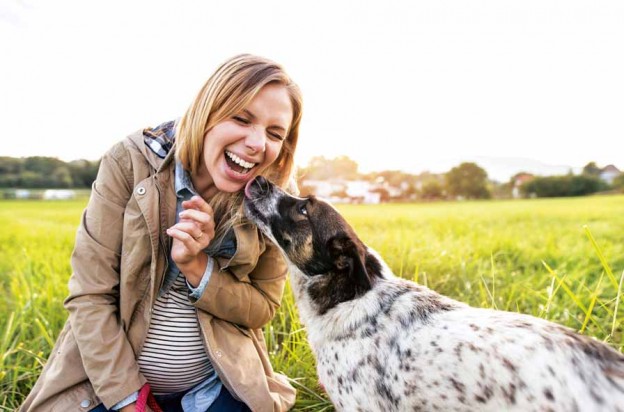
Is your dog an overenthusiastic greeter? Carrol Baker explains how
to deal with this challenging problem.
We’ve all been there: wiping doggy drool off our chin when an excitable pooch has licked our face in greeting, or having almost been bowled over by a large dog jumping up to say hello. Teaching how to greet properly is an important part of establishing canine etiquette. But, according to the experts, it’s something many of us get wrong.
Your greeting ritual with your dog should be calm. You may think that by saying hello in an overexcited way that you’re letting the dog know how much he or she means to you but, according to Emma Tucker from SitDropStay Dog Training on the Gold Coast, by greeting your dog in an overexcited manner, you may be doing more harm than good.
“If there is an intense overstimulating energy, it can be stressful for the dog,” she says. “From your dog’s perspective, your behaviour is unstable and weak, the opposite of what they actually crave in a leader.”
The same applies when it’s time to say goodbye when you leave the house. Don’t make a big deal of it. Pop a couple of doggy treats in a KONG, or leave a bone to chew, and off you go — without making a fuss.
Saying g’day the right way
Let’s start with puppies. When you have been separated from your puppy and you reunite, walk into the home calmly and with purpose. The key is to not show any attention or affection until your puppy is also calm. “Stay disengaged and when the puppy is quiet and relaxed, invite them into your space,” Emma says. “You’re letting the dog know the behaviour you want and then rewarding them. But don’t overdo it or you’ll trigger the behaviour you want to avoid!”
It’s up to you to show your dog the sort of behaviour you expect and to keep your emotions in check. As cute and cuddly as your puppy is, if you don’t teach it the right way, it will be much harder to correct when the dog is older.
“Teaching your dog to respect personal space and use self-control are the two biggest concepts to focus on if you want your dog to greet people and other dogs respectfully and politely,” Emma says. “If you don’t take control, your dog will.”
Can you teach an old dog new tricks?
Teaching an older dog how to greet politely requires the same process as teaching an overexcited puppy, but you’ll need a lot of patience. “Again, think calm and powerful and refuse to give them attention until they calm down and give you space,” Emma says. With an older dog, the behaviour is ingrained — the dog has learned that if it jumps up or licks, it’ll be rewarded with attention.
“Allowing a dog to jump up on you uninvited will confuse them about who is in charge and can quickly lead to a disrespectful attitude in general,” Emma explains.
Be clear with what you expect. If your dog doesn’t respond with the appropriate behaviour and continues to jump up after you have tried behaviour training for a couple of weeks (at most), it can help to consult with a dog trainer.
Greeting those who don’t like dogs
As hard as it is to imagine for dog lovers, there are people who simply don’t like dogs. And, of course, the last thing you want is for your dog to frighten your visitor.
Your dog should never approach a visitor until she is invited over to say hello. It can also help to teach your dog to go to a bed or mat and wait calmly. “If your dog isn’t fully under your voice control, put your dog on a lead first and show them the behaviour you want,” Emma says. “Use the lead both inside and outside the house until the behaviour you want is completely established and your dog is fully under your control.”
Dogs greeting dogs
Dogs should always wait for permission to enter another dog’s or human’s space. “Use a lead and when both dogs are calm and polite, give the OK command and allow them to meet. If they aren’t calm and polite, they don’t get to say hello,” Emma says. “Rules and structure are really important. Once manners are established on-lead and I have full voice control, I then discontinue using the lead.”
Ultimately, it can take some time to achieve the appropriate behaviour response from your dog but with practice and patience, you should end up with a playful pooch that has just the right amount of manners. And, as Emma suggests, don’t be afraid to consult a dog trainer or behaviourist who can lead you and Fido in the right direction.
This article was originally published in DOGSLife #142. Click here to subscribe to our pawsome magazine.
Make sure your furry friend is always looked after at our DOGSLife Directory



